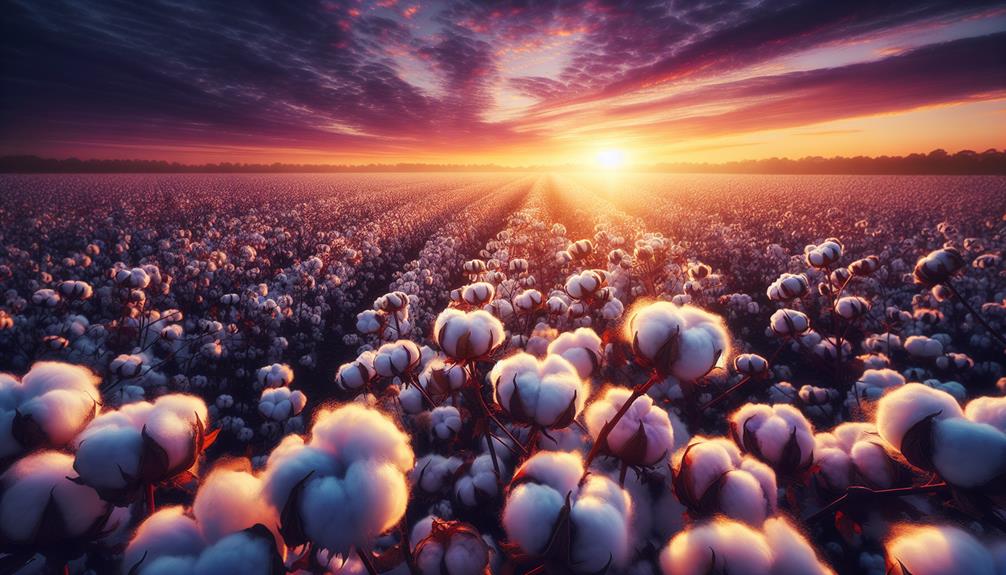Cotton is a material due to its versatility and comfort. It absorbs moisture well and is breathable, ideal for various products. From ancient civilizations to modern innovations, cotton's journey showcases human creativity. Its production involves multiple steps and has global economic importance. Cotton's impact on the environment varies, leading to sustainable farming practices. With different types like twill and denim, cotton caters to diverse needs. The rich history and properties of cotton make it a fascinating material worth exploring further.
Table of Contents
Key Takeaways
- Cotton is a material due to its natural fiber structure.
- It is highly absorbent and breathable, making it ideal for textiles.
- Cotton's versatility allows for various fabric types like twill, denim, and jersey.
- The global economic importance of cotton as a primary textile material is significant.
- Cotton's historical and cultural significance in textile production is profound.
Origins of Cotton
Since ancient times, cotton cultivation has played a pivotal role in various civilizations, with evidence of its use dating back to the fifth millennium B.C. in the Indus Valley Civilization.
As one of the earliest forms of natural fiber known to humans, cotton quickly became a cornerstone in textile production due to its versatility and comfort. Ancient cultures, including the Greeks and Egyptians, recognized the value of cotton, utilizing it for various purposes such as clothing and household items.
The journey of cotton from being a wild plant to a cultivated crop showcases human innovation and adaptability. With the Arab merchants' role in introducing cotton to Europe during the medieval period, its popularity and demand surged, leading to further advancements in cultivation techniques.
This early history of cotton cultivation highlights its enduring significance as a fundamental natural resource that has shaped the course of textile production and global trade.
Cotton Fabric Properties
Cotton fabric is renowned for its exceptional absorbency, drawing moisture away from the body and keeping the skin feeling dry. Additionally, its breathability guarantees a cool and comfortable wear, especially in warmer climates.
These properties make cotton a popular choice for a wide range of clothing and textile products.
Absorbency of Cotton
With its remarkable ability to retain moisture, cotton stands out as a top choice for fabrics designed to keep you dry and comfortable. The absorbent nature of cotton fibers, due to the hydrophilic nature of cellulose, makes it perfect for a variety of uses.
Here's why cotton's absorbency is exceptional:
- Cotton can hold up to 27 times its weight in water.
- Ideal for towels, bathrobes, and other moisture-wicking textiles.
- Unique structure enables quick absorption and release of moisture.
- Comfortable to wear in warm weather and for various hygiene products.
Cotton's absorbent properties not only make it practical but also contribute to its reputation for being a go-to fabric for everyday comfort.
Breathability in Cotton
Boasting exceptional breathability, cotton fabric effortlessly allows air circulation to keep the body cool and comfortable. The natural fibers in cotton play a key role in this property, creating an environment where air can flow freely, making it a top choice for warm-weather clothing.
This breathability not only helps in regulating body temperature but also enables moisture-wicking, drawing sweat away from the skin and aiding in its evaporation. Whether in casual wear or sportswear, the comfort provided by the breathability of cotton fabric is unmatched.
Its ability to keep you feeling fresh and dry makes it a versatile and popular option for everyday garments, showcasing the enduring appeal of this natural material.
Cotton Fabric Production Process
The process of creating cotton fabric begins with harvesting cotton from bolls and then goes through several key stages like cleaning, carding, spinning, and weaving before becoming the final fabric. The production of cotton fabric involves the following steps:
- Harvesting cotton from bolls in fields.
- Cleaning the harvested cotton to remove impurities.
- Carding the cotton fibers to align them in the same direction.
- Spinning the carded fibers into yarn for weaving.
Eli Whitney's invention of the cotton gin in 1794 greatly sped up the process of separating cotton fibers from seeds, revolutionizing cotton production.
Today, cotton is planted in the spring and harvested using automated machines within 55-80 days. Major cotton-producing countries like India, China, USA, Brazil, Pakistan, and Australia play a crucial role in the global cotton industry, collectively supplying the majority of the world's cotton.
This multi-step manufacturing process transforms raw cotton fibers into the versatile woven fabric used in various textile applications.
Environmental Impact of Cotton
Cotton production has a significant environmental impact, mainly due to its high water usage and the agrochemicals involved in cultivation. These factors can lead to water pollution and soil degradation, highlighting the need for more sustainable practices like organic farming to mitigate these effects.
Water Usage in Cotton
With each kilogram of cotton produced globally, a significant 8,000-10,000 liters of water are required, emphasizing the vital water usage in cotton cultivation. When considering water usage in cotton:
- Cotton cultivation globally requires 8,000-10,000 liters of water per kilogram of cotton produced.
- Water scarcity poses challenges for cotton cultivation, especially in arid regions where water resources are limited.
- Improper cropping and irrigation practices in cotton farming can lead to environmental issues like desertification.
- Essential water management practices are vital to mitigate the environmental impact of water-intensive cotton cultivation.
Efficient water use and conservation strategies are essential due to cotton's large water footprint, highlighting the importance of sustainable practices in the industry.
Pesticides in Cotton
Amidst the vast environmental impact of cotton cultivation, the pervasive use of pesticides poses a significant threat to ecosystems and water quality. In conventional cotton farming, insecticides like organophosphates and pyrethroids are extensively used, contributing to 16% of global insecticide use and 7% of pesticide sales.
Runoff from pesticide-treated cotton fields can contaminate water sources, harming aquatic life and disrupting ecosystems. However, opting for organic cotton can mitigate these risks by eliminating synthetic pesticides, promoting healthier ecosystems, and protecting water quality.
Types of Cotton Fabric
Exploring the diverse world of cotton fabric reveals a range of types such as plain cotton, combed cotton, organic cotton, and Pima cotton. Each type offers unique characteristics and applications that cater to different preferences and needs.
Some popular variations of cotton fabric include cotton twill, flannel, chambray, and jersey, each known for its distinct texture and utility. Denim, muslin, canvas, and terrycloth are commonly used types of cotton fabric due to their durability and versatility.
Additionally, fabrics like poplin, sateen, voile, and corduroy stand out for their special textures and are used in various clothing items and home textiles.
- Cotton twill, flannel, chambray, and jersey
- Denim, muslin, canvas, and terrycloth
- Poplin, sateen, voile, and corduroy
- Cotton blends like polyester-cotton or spandex-cotton
Sustainability in Cotton Farming
Considering the increasing focus on environmental sustainability, organic cotton farming has emerged as an essential practice in the textile industry. Organic cotton farming avoids synthetic pesticides and fertilizers, making it a more sustainable option. It contributes positively to sustainability efforts by promoting soil health and reducing harmful chemical runoff into water sources. Fairtrade cotton is another important aspect of sustainability in cotton farming, ensuring fair wages and labor conditions for workers in the industry.
Sustainable practices play a pivotal role in maintaining ecological balance. Water conservation techniques and soil health management are integral parts of sustainable cotton farming. Additionally, the innovative approach of using recycled cotton supports sustainability in the textile industry by reducing waste and the need for new raw materials.
In contrast, conventional cotton farming can have negative environmental impacts due to the heavy use of pesticides and water. This highlights the importance of shifting towards more sustainable cotton farming practices to safeguard our environment for future generations.
Global Cotton Production
As we shift our focus to Global Cotton Production, it becomes evident that China leads the world as the largest producer of cotton, with India and the United States following closely behind.
- Cotton gins are essential in separating cotton fibers from the seeds.
- Cottonseed, a byproduct of cotton production, finds use in products like oil and animal feed.
- Cotton yarn, spun from cotton fibers, is the primary material for textiles worldwide.
- Despite advancements in synthetic materials, cotton remains somewhat irreplaceable due to its breathability and comfort.
Global cotton production not only fuels the textile industry but also influences various sectors like agriculture, manufacturing, and trade. The utilization of cotton byproducts in diverse industries underscores the economic significance of cotton cultivation on a global scale. From the fields where cotton is grown to the finished products on store shelves, the journey of cotton showcases its integral role in the world economy.
Economic Importance of Cotton
The economic significance of cotton is undeniable, impacting various industries and livelihoods worldwide. With over 25 million metric tons of global cotton production annually, the cotton industry plays a vital role in supporting millions of people, from farmers to textile manufacturers. Countries like the United States, India, and Brazil heavily rely on cotton exports, highlighting its importance in international trade. Cotton is a key commodity in the textile industry, influencing fashion and apparel markets globally.
Moreover, the economic importance of cotton extends beyond clothing. Byproducts like cottonseed oil and meal find applications in diverse industries such as food, cosmetics, and animal feed. This versatility enhances the economic value of cotton, making it a valuable asset beyond its primary use in textiles. The demand for cotton continues to drive economic growth and innovation, showcasing its significance in various sectors of the economy.
Frequently Asked Questions
Is Cotton a Material?
Yes, cotton is a material. It's a natural fiber with breathability and moisture-wicking properties. It's versatile and used in various products. Cottonseed oil is also extracted from its seeds for cooking and cosmetics.
Why Is Cotton a Good Material?
Cotton is a good material because of its breathability, moisture-wicking properties, durability, and ease of care. Blending it with other fibers enhances its versatility. Sustainable farming practices and various uses like cottonseed oil further add to its value.
How Does Cotton Become a Fabric?
I pick cotton in spring, harvest it in 55-80 days, then machines separate fibers. After cleaning, carding, spinning, and weaving, cotton becomes fabric. It's a versatile textile used worldwide. The process is fascinating.
What Makes Cotton Special?
Breathability, comfort, and versatility make cotton special. Its moisture-wicking properties and durability are unmatched. Blending with fibers like polyester enhances its characteristics. From fashion to medical supplies, cotton's unique properties shine, appealing to various industries.
- How Does Ring Spun Cotton Affect Garment Fit and Shape Retention? - August 13, 2024
- What Are the Challenges in Producing Ring Spun Cotton? - August 13, 2024
- Is Ring Spun Cotton Suitable for Plus-Size Clothing? - August 13, 2024





